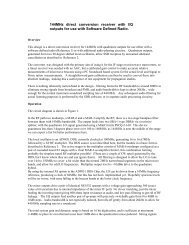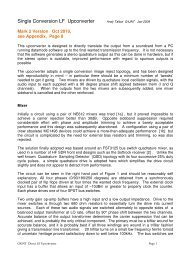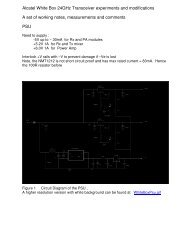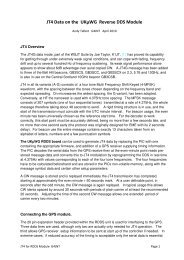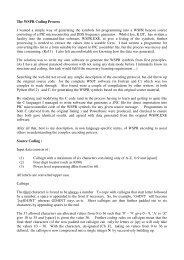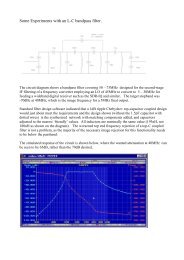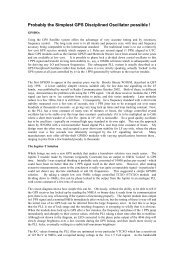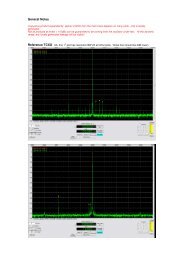Software Manual - G4JNT
Software Manual - G4JNT
Software Manual - G4JNT
You also want an ePaper? Increase the reach of your titles
YUMPU automatically turns print PDFs into web optimized ePapers that Google loves.
at 64 for each channel, so the final measurement for the first channel is a number in the range zero<br />
to 16383 * 64 = 104851 This is divided by 256 by the simple expedient of throwing away the least<br />
significant byte, leaving a two byte value holding a number in the range 0 – 4095. This is converted<br />
to BCD and sent to the display. The whole process is then repeated for the other three<br />
measurement channels<br />
The main loop is continually testing the button input line press and measuring the duration of any<br />
press. Action is then taken on long or short presses accordingly. Study the source code listing for<br />
full details. The names of all the appropriate subroutines should be self explanatory, and all<br />
relevant sections of the PIC code are commented.<br />
To gain experience with PIC programming, try adjusting the four constants stored in EEProm to give<br />
scaling factors other than just the powers of 10 corresponding to decimal point placement. A value<br />
of 32 stored in the appropriate location, for example, will cause a value to be displayed in the range<br />
0 – 2.047 (or 20.47, or 204.7) for that channel. Other numbers can be selected for arbitrary scaling<br />
in the range 1 – 255, allowing multiplication of between 1/64 to 255/64 (.0156 to 3.98) to be<br />
applied to the displayed value. To change these EEProm –stored values, a PIC programmer such as<br />
the PicKit 2 and a code assembler like MPASM will be needed .<br />
For further enhancements, modify the code to for stored offsets – addition subtraction routines can<br />
be found in other listings within this archive.<br />
Auto SWR Bridge Display<br />
To be able to use this PIC code, you will first have to make/obtain/modify an RF head to deliver two<br />
DC output voltages corresponding to Forward and Return signals. Ensure this is properly balanced,<br />
ie gives similar voltages on FWD and REF when the direction of RF flow is reversed, and that the<br />
voltage output during normal operation, including under mismatch conditions does nor exceed<br />
4.09V For accuracy and linearity, it is usually better to design for a higher voltage out from the<br />
diodes and use a potential divider to bring this down to the input voltage range – which also allows<br />
for calibration and balancing.<br />
Three analogue measurement channels are needed for the full SWR and power indication; Chan 1<br />
(Pin-0 on the 8-way header ) takes the FWD voltage, Pin-1 the REF and pin-2 the power calibration<br />
input. The power calibration uses the 4.096V reference output, so a resistor of a value determined<br />
below needs to be installed in the R4 position. Non-critical valued resistors of a few hundred ohms<br />
to 1kΩ can be installed at R1 – R3 positions with C1-C3 to add RF decoupling and filtering.<br />
SWR is calculated by measuring the voltage on the FWD and REF inputs and calculating the ratio<br />
between them. Provided the analogue channels are matched, no other calibration is needed. Power<br />
measurement, on the other hand, requires user calibration, which can only really be made in<br />
conjunction with another, calibrated power meter. Therefore, the digital power reading here is<br />
obtained by measuring the FWD voltage reading, squaring it (as Power is proportional to V 2 ) then<br />
multiplying by a value obtained by measuring a voltage on the third channel. This is turn is set<br />
<strong>G4JNT</strong> PIC Controller <strong>Software</strong> <strong>Manual</strong>. Page 3



